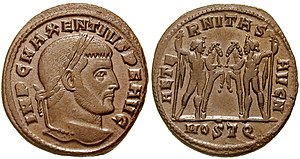Maxentius
The latter defeated him at the Battle of the Milvian Bridge in 312, where Maxentius, with his army in flight, purportedly perished by drowning in the Tiber river.
Although two sons of emperors – Constantine and Maxentius – were available, they were passed over for the new tetrarchy, and Valerius Severus and Maximinus Daza were appointed Caesars.
When Constantius died in 306, his son Constantine was crowned emperor on July 25 and subsequently accepted by Galerius into the Tetrarchy as Caesar.
Maxentius accepted the honour, promised donations to the city's troops, and was publicly acclaimed emperor on 28 October 306.
Maxentius refrained from using the titles Augustus or Caesar at first and styled himself princeps invictus ("undefeated prince"), in the hope of obtaining recognition of his reign by the senior emperor Galerius.
Constantine firmly controlled his father's army and territories, and Galerius could pretend that his accession was part of the regular succession in the tetrarchy, but neither was the case with Maxentius: he would be the fifth emperor, and he had only few troops at his command.
Galerius reckoned that it would be not too difficult to quell the usurpation, and early in 307, the Augustus Severus marched on Rome with a large army.
The joint rule of Maxentius and Maximian in Rome was tested further when Galerius marched to Italy in the summer of 307 with an even larger army.
While negotiating with the invader, Maxentius could repeat what he did to Severus, by the promise of large sums of money and the authority of Maximian, many soldiers of Galerius defected to him.
In the conference of Carnuntum, in the autumn of that same year, Maxentius was once again denied recognition as legitimate emperor, and Licinius was appointed Augustus with the task of regaining the lost domains.
[7] In the meantime, Maxentius fortified northern Italy against potential invasions and sent a small army to Africa under the command of his praetorian prefect Rufius Volusianus which defeated and executed the usurper Domitius Alexander in 310 or 311.
[10][11] Without the revenues of the empire, Maxentius was forced to resume taxation in Italy to support his army and his building projects in Rome.
[12] The election of a bishop did not aid much, either, as Diocletian's persecution had split the Italian church into competing factions over the issue of apostasy (see Donatism).
[15] As early as weather permitted,[15] late in the spring of 312,[20] Constantine crossed the Alps with a quarter of his army,[citation needed] a force equivalent to something less than forty thousand men.
[15] Having crossed the Cottian Alps at the Mont Cenis pass,[20] he first came to Segusium (Susa, Italy), a heavily fortified town containing a military garrison, which shut its gates to him.
[21] At the approach to the west of the important city of Augusta Taurinorum (Turin, Italy), Constantine encountered a large force of heavily armed Maxentian cavalry,[22] labeled clibanarii or cataphracti in the ancient sources.
[25] It was expected that Maxentius would try the same strategy as against Severus and Galerius earlier; that is, remaining in the well-defended city of Rome, and sit out a siege which would cost his enemy much more.
Christian tradition, especially Lactantius and Eusebius of Caesarea, claims that Constantine fought under the labarum in that battle, revealed to him in a dream.
Studies conducted between 2021 and 2022 have made it possible to identify the manuscript tradition of Maxentius' epistles, which have undergone numerous interpolations and attempts of forgery to adapt the texts to a pro-Constantinian hagiographic narrative (Passio of Saint Catherine).
A comparison with Roman law, legal papyri and the primary sources such as Diocletian's Senateconsult and edict of persecution has allowed an integrated critical reconstruction of the original texts, which perfectly mirrors what Eusebius of Caesarea, Optatus of Milevi and Saint Augustine report about Maxentius' pro-Christian policy.
[27] In December 2006, Italian archaeologists announced that an excavation under a shrine near the Palatine Hill had unearthed several items in wooden boxes, which they identified as the imperial regalia, possibly belonging to Maxentius.
The most important find was a sceptre of a flower holding a blue-green globe, which is believed to have belonged to the Emperor himself because of its intricate workmanship, and has been dated to his rule.
Panella notes that the insignia were likely hidden by Maxentius' supporters in an attempt to preserve the emperor's memory after he was defeated at the Battle of the Milvian Bridge by Constantine.








